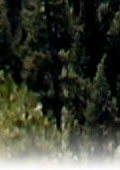Road Stabilization and Improvement Demonstration Project
Sponsored by the Trinity Resource Conservation & Development Council
The disposal of the small trees, brush and branches that are removed during fuels reduction or defensible projects has frequently been one of the big challenges with these important projects. Everyone is always looking for ways to find a use for this woody material. This summer the District, in cooperation with private landowners and the Trinity Resource Conservation and Development Council tried a new approach.
The District completed a demonstration project using chunks of chipped wood (Chunkwood) for road surfacing material this summer. One parking area and two roads in the Oregon Mountain area were selected for this innovative project that used wood chips and chunks from the Districtís fuels reduction project in the same area.
The concept of chunkwood for road surfacing was introduced in the mid-1970ís. It provides a clean and stable material for stabilization and erosion control on light duty, low-use roads, parking and access areas. It is an alternative to more costly materials such as rock or shale, and in this demonstration the chips are produced nearby on the fuels reduction project.
Initially, the project sites were prepared by correcting minor drainage concerns. Next, the areas were graded and shaped. Geo-textile fabric was installed over the prepared road surface. Finally a 4 to 8 inch layer of wood chunks/chips was applied. Project Manager John Condon described the benefits of this project. It tied it into an existing fuels reduction project; allowed the District to expand the fuels treatment area, because of cost-savings on both projects; used the biomass generated from the fuels project (the wood chips) on-site; and reduced our reliance on the more costly disposal method of burning.
This project was completed with funding from U.S. Forest Service under the Economic Action Program of the National Fire Plan through a grant to the Trinity Resource Conservation & Development Council (RC&D), which sounds a lot like the Trinity County Resource Conservation District (RCD).
For additional information contact:
Scott Eberly, Coordinator
Trinity RC&D
(530) 623-2009 ext. 3
This issue of the Conservation Almanac is funded in part by grants from the
Trinity River Restoration Program, California Fire Safe Council, and the State Water Resources Control Board
|


